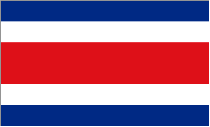National Node

SSC Representative
- Daniel Janzen
- Area de Conservacion Guanacaste, Costa Rica
SSC Alternate
- Carlos Hernández
- Instituto Nacional de Biodiversidad (INBio)
Vision
1. Provide the world with one example of a thoroughly barcoded tritrophic lineage of one large complex conserved tropical wildland: 'Lepidoptera-food plants-parasitoids' of Area de Conservacion Guanacaste, northwestern Costa Rica, 2.5% of the world's biodiversity in one place.
2. Barcode the national biodiversity of Costa Rica, 4% of the world's biodiversity, as a major action in making that biodiversity available to everyone anywhere at any time for non-damaging use and biodiversity development, for the conservation of that biodiversity and to make that biodiversity a sustainable integral part of the national socioeconomic fabric into perpetuity.
3. Conduct the two actions described above in a transparent and exemplary manner for the world as case histories and proof-of-principle, and as direct biodiversity development actions for and by the country of Costa Rica.
Mission
1. Thoroughly barcode all the species of Lepidoptera, their food plants, and their parasitoids (Diptera, Hymenoptera) obtained by the ongoing 33-year old intense biodiversity inventory of Area de Conservacion Guanacaste, northwestern Costa Rica; 30,000 samples/year of 2,000+ species/year with funds now (2011) available.
2. Barcode at least 10,000 samples of 1,000+ species, as funding allows, of the massive national inventory biodiversity collections (many millions of specimens) housed in INBio since 1989; all specimens and human resources are in place (or can be obtained in short order), this has been funded by IDRC, with ongoing support from the JRS Biodiversity Foundation grant to ACG/GDFCF.
3. Conduct the two actions described above in a transparent and exemplary manner for the world as case histories and proof-of-principle, as well as for the direct biodiversity development benefit of Costa Rica and its national conservation process.
Goals
1. For the ACG tritrophic inventory, provide 30,000 samples to BIO for barcoding per year, all properly databased, and then continue the taxonomic curation of these samples in consort with the barcoding results (JRS grant), while producing published and database analyses, and while serving as proof-of-principle for INBio, CBOL, iBIOL and BIO, in return for iBOL covering the barcoding costs once the samples are prepared for sending.
2. For the INBio national inventory collections, provide 10,000 INBio collection samples to BIO for barcoding per year as supported by the current IDRC funding, all properly databased, and then continue the taxonomic curation of these samples in consort with the barcoding results, while producing published and database analyses and serving as proof-of-principle for CBOL, iBOL and BIO, in return for iBOL covering the barcoding costs once the samples are prepared for sending. AND, treating this as a module, produce more such modules per year as equal amounts of funding are made available by iBOL.
3. Conduct the two actions described above in a transparent and exemplary manner for the world as case histories and proof-of-principle, as well as for the direct biodiversity development benefit of Costa Rica and its national conservation process.


 Costa Rica
Costa Rica